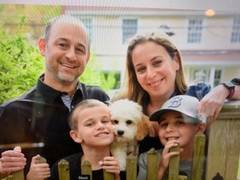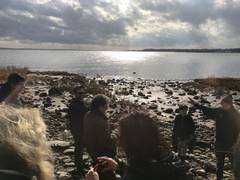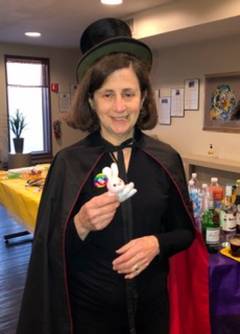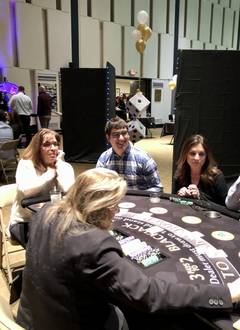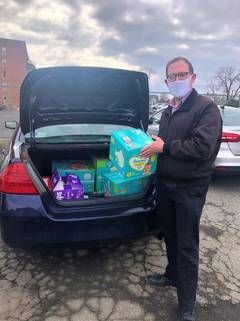Yom Kippur/Yizkor 5779: Choice
09/20/2018 07:56:29 PM
| Author | |
| Date Added | |
| Automatically create summary | |
| Summary |
“Why me” is a question most of us have probably asked at some point in our lives. Something difficult, painful, or tragic happens. We are then left wondering what we are to make of our experience. We look for someone or something to blame. We even blame ourselves: If only I had… It can feel like our entire lives can be divided into a before and an after.
If anyone ever had reason to ask “Why me?”, it is Edith Eva Eger. Edith was born to a Hungarian-Jewish family in Czechoslovakia in 1928. She had a relatively happy childhood and focused her energies on training as a gymnast and dancer.
But then the war started, and her family, like Jewish families across Europe, was pulled into the Nazi abyss. Edith lost both of her parents during the Holocaust and survived being marched from camp to camp in the closing months of the war. By the time she was liberated by the American army, she weighed very little and had a broken back.
Edith is still alive today, and published a memoir about a year ago. What sets her memoir apart is that in some ways, her experiences during the Holocaust, which she recounts in detail, are only the backstory. She recounts how she and her two sisters attempted to rebuild their lives in Europe after the war, and how, through a combination of luck and determination, were able to immigrate to the US and start new lives here.
Edith eventually found a career as a clinical psychologist. Her own traumatic experiences became the basis for how she helps her patients deal with their own difficult moments. Through treating individuals, consulting, and speaking, she developed an expertise in the treatment of trauma. She has helped people from many different walks of life, facing many different problems, discover how they can heal. In particular, she has long worked with people in the military to help them deal with the psychological toll of war.
Edith's memoir is called The Choice: Embrace the Possible. Today, on Yom Kippur, as we prepare to remember our loved ones during the Yizkor service, I want to take us through three of Edith's core messages.
The first message, as the title of the book suggests, is the possibility and importance of choice. From her personal and professional experiences as a Holocaust survivor and psychologist, Edith learned that, “suffering is universal. But victimhood is optional” (7).
But our suffering need not determine our fate. We can react with all of the physical and psychological symptoms of trauma. We can choose, she writes, to “develop a victim's mind�"a way of thinking and being that is rigid, blaming, pessimistic, stuck in the past, unforgiving, punitive and without healthy limits” (7).
To be clear, Edith is not blaming people for the traumatic things that happen to them, which are usually beyond their control. Rather, she is pointing out that we have the capacity to choose how to respond when�"and that's a when, not an if�"they occur. “We cannot choose,” she writes, “to have a life free of hurt. But we can choose to be free, to escape the past, no matter what befalls us, and to embrace the possible” (9).
In this sense, Edith's work is in the tradition of her mentor and fellow Holocaust survivor Viktor Frankl, who wrote, “When we are no longer able to change a situation, we are challenged to change ourselves.”
The key to making these changes, Edith suggests, is to focus on the present. Both Edith and her patients tended to live in the past, to say “if only” something or other had been different. Or, they lived in the future, making their well-being conditional on some future achievement: “I won't be happy until” this or that happens (173). As a therapist, Edith helps her clients identify patterns of behavior and their underlying beliefs. Then they can take responsibility for their behavior, including choosing what they need to stop doing, in order to take better care of themselves.
This is not easy, as Edith knows from her own lifetime of experience as a survivor. At a certain point in her life, Edith chose to visit Auschwitz, the place where her parents were killed and where she spent months in the shadow of death. During that visit, she flashed back to her arrival at Auschwitz as a teenager, when her family got off the train and were sorted, they quickly learned, between life and death.
With her mother and sister, Edith approached the infamous Dr. Mengele. “Is she your mother or your sister?” he asked. Unsure of the significance of this question, and feeling only a child's need for her mother, she said, “Mother.” Edith immediately realized that she had made the wrong choice, as she watched her mother put in line towards death with the nursing mothers and elderly women. Across the decades, Edith still understandably felt felt a tremendous amount of guilt. “I would live it all again,” she writes, “every selection line, every shower…every time I nearly died or wanted to, if I could only live this moment over…when I could have made a different choice” (231).
But standing there again all of those years later, Edith realized just how much power she was giving to that past choice that, no matter how guilty she felt, could not be changed. In a moving passage, she reflects: “Could I have saved my mother? Maybe. And I will live for all of the rest of my life with that possibility. And I can castigate myself for having made the wrong choice. That is my prerogative. Or I can accept that the more important choice is not the one I made…when we were surrounded by dogs and guns and uncertainty… it's the one I make now. The choice to accept myself as I am: human, imperfect. And the choice to… to survive and to thrive so I can use every moment to make the world a better place…I can't ever change the past. But there is a life I can save: It is mine. The one I am living right now, this precious moment” (232).
This day, Yom Kippur, is perhaps the ultimate such precious moment. We experience these 25 hours suspended from our usual surroundings and our usual bodily needs. We use this time to look both backward into the past and forward into the future. And like Edith, like her patients, like everyone at every moment, we have some choices to make. We can let our past determine our future. We can fall into the same self-defeating and irresponsible behaviors that have led us astray again and again.
Or: we can choose differently. Yom Kippur presents us with the opportunity, if we are brave enough to take it, to choose a different future for ourselves. To break out of bad habits and patterns. To admit we have done wrong and to commit to do better in the future. To choose life. We can't change the past. But we can choose to change the future. That is the gift of this present moment. That is the gift of this and every Yom Kippur: the opportunity to make different choices in this new year.
This brings me to the second of the core messages of Edith's book: the importance of forgiveness.
Once, after her reputation as a clinician and speaker was well-established, Edith was invited to address a group of US Army chaplains stationed in Germany. The chaplains, who ministered to American soldiers on high alert during the Cold War, were gathered at a retreat center which had once been a guest house for the SS. Edith was to stay at a nearby hotel that had once served Hitler's high officials and visiting diplomats. What remained of the Berghof, Hitler's mountain residence, was part of the same complex. After much consideration, Edith decided to accept the invitation, to return to Germany for the first time since the war. As difficult as returning would be, she decided it wouldn't stop her from being of service to the same army that saved her life. So she went. Her topic? Hope and forgiveness.
On the train ride there, Edith and her husband shared a compartment with a lovely German couple. Edith found herself thinking about what they were up to during the war. “The dread in me turns to something else, a fiery and jagged feeling, fury,” Edith recalls. “I am sitting inches away from people who might be my former oppressors. I am afraid of what I might do.” (209). She wanted to end the trip right there, but her husband reminded her that this is the work of healing: welcoming and embracing what most makes you afraid, in order to then finally release it.
They arrived, and checked in to what was once the bedroom of Joseph Goebbels, Hitler's minister of propaganda. Edith headed outside alone for a walk. At first, she didn't want to look at the site of Hitler's residence. But then she realized that staying away would just give a dead man the power to cut off her own discovery, her own ability to learn from her past. So she went to have a look at the moss-covered retaining wall that was all that remained.
She was surprised by how quiet and peaceful the place was now. “I am walking on the same steps that Hitler once took, but he isn't here now, I am,” she reflected (210). “Within the layers of the terrible sorrow I carry in me always, another feeling shoots through. It is the first melting trickle of long-frozen snow…I am alive…I made it…“I release you!” I shout to that old sorrow.” (211)
The next day, she spoke to the group of army chaplains. She explained that she has not at all overcome her past. Every brutal experience she had lives on in her memories and nightmares. “The past isn't gone,” she told the chaplains. “It lives on in me. But so does the perspective it has afforded me: that I lived to see liberation because I kept hope alive in my heart. That I lived to see freedom because I learned to forgive” (211).
She continued to explain that forgiveness is very difficult, compared to the alternative of holding grudges and seeking revenge. Edith's fellow survivors would give her pained looks when she mentioned forgiveness as a strategy for coping with their loss and pain. But Edith realized that not forgiving only turns pain into a prison. Her experience in Germany taught her that bearing a grudge and seeking revenge of any kind would not set her free.
“So,” Edith writes, “I stood on the site of Hitler's former home and forgave him… It was something I did for me… As long as I was holding on to that rage, I was in chains with him, locked in the damaging past, locked in my grief” (212).
Like perhaps you are, I was shocked when I read Edith's words. Forgiving Hitler? After everything he did to her and her family? Edith explains that forgiveness isn't about forgetting or excusing what happened in the past. It certainly doesn't change what happened, either. But, Edith clarifies, “To forgive is to grieve�"for what happened, for what didn't happen�"and to give up the need for a different past. To accept life as it was and as it is.”
Edith survived. And she had a choice about how to use the life she had fought for against all odds. She could let her past pain dictate every decision. Or, she could give up her need for a different past. She could accept what happened and let go of her anger and desire for revenge. And then she could choose how she wanted to live the rest of her life, rather than letting her past choose for her.
Now, this is really, really difficult to do. It took Edith years of pain and soul-searching to reach this point. And even still, the pain and trauma never totally went away. Her book is also full of accounts of her helping her patients go through this process with varying degrees of success.
But Edith's story helps us understand this day, Yom Kippur, whose byword is forgiveness. The Talmud (Megillah 17b) suggests that forgiveness is a form of healing. Forgiveness takes something broken and tries to make it whole again; it takes something sick and tries to make it well. When we heal from physical injury, we often are not back to exactly where we were before. There remains a scar or a disability or other lasting impacts of the injury. So too with emotional injury. We can never get back to exactly where we were before. But, through forgiveness, through letting go of the need for a different past, we are then better able to face the future.
We begin Yom Kippur with such a letting go. Last night, we entered this holy day with Kol Nidre, with a release of the unfulfilled religious vows of the past year. In a broader sense, in that moment we forgave ourselves and others. We publically acknowledged that the unrealized goals and unfulfilled promises we made for ourselves in the past year will not determine how next year will unfold.
But even as we forgive, even as we find the strength to let go, we know that the traumas and failures of the past never totally go away. This brings me to the third lesson from Edith's story: that our most traumatic experiences can be a source of wisdom.
Like many survivors in the decades following the Holocaust, Edith did not want to, and was not encouraged to, talk about her experiences. She focused on building her new life in America and trying to move on. But like a festering wound, the impact of her frightening experiences continued to haunt her in ways she could barely acknowledge.
But then, one day, after she returned to school as the mother of three children, a fellow student gave her something that changed her life. Sitting down next to her, this student asked, “You were there, weren't you?”
“There?” Edith ask, the panic rising in her.
“Auschwitz. You're a survivor, aren't you?”
Edith was rattled by the question. How did he know, she pondered. She did everything she could not to think about the past, not to concede to the horrors she experienced. Finally, though, she admitted that she was survivor, a fact of her past that at the time she discussed with almost no one.
“Have you read this?” her classmate asked. It was a battered paperback copy of Viktor Frankl's classic Man's Search for Meaning. Edith accepted the book but hesitated to open it. Why would she put herself back through her hellish experience? But when she finally opened the book, it changed her life. To her surprise, reading about Frankl's own experience in the camps did not make her afraid. “For every page I read, I want to write ten,” she remembers. “What if telling my story could lighten its grip instead of tightening it? What if speaking about the past could heal it instead of calcify it?” she wondered (156).
This moment led to her interest in psychology and eventually to becoming Frankl's student and colleague. Most importantly, it led Edith to, in her words, “formulate a new relationship with my own trauma. It wasn't something to silence, suppress, avoid, negate. It was a well I could draw on, a deep source of understanding and intuition” (181). Edith realized that her painful experiences were, in a way, a gift, one she never would have chosen to receive, but that nonetheless gave her the opportunity to find her unique path through life. Rather than suppressing her past, she embraced it, and it changed her life and that of her patients. As Edith suggests, “Maybe to heal isn't to erase the scar, or even to make the scar. To heal is to cherish the wound” (225).
In its own way, Yom Kippur is a banner example of how we as Jews have learned to cherish our wounds. Thousands of years ago, Yom Kippur focused on the purification of the Temple in Jerusalem by means of an elaborate set of rituals. The day focused on removing the built-up ritual impurity from the Temple so that it could continue to function as the meeting place for God and the people Israel in the year ahead.
The Temple, of course, has not stood for two thousand years. Our ancient rabbis re-fashioned the holiday to reflect this traumatic loss. Instead of centering the holiday around these purification rituals, we now focus on personal repentance by means of prayer, reconciliation and charitable giving.
But the rabbinic Yom Kippur never entirely let go of the old Temple rituals. We read about them during the Torah service, and we re-enact them during the Avodah service later on. That part of the service provides a detailed, poetic description of the ritual, as well as reflections on the loss of the Temple and the grandeur that once filled it on Yom Kippur.
The destruction of the Temple could have meant the end of Judaism. Our ancient rabbis yearned for it to be rebuilt. But they realized that the loss of the Temple could also become a source of wisdom. Its absence pointed towards a new form of Judaism that is more or less still with us today.
In place of sacrifices, the rabbis instituted prayer, study and acts of loving kindness as ways of coming closer to God. Instead of centering Judaism on a physical Temple in Jerusalem, it was now centered on a set of texts, ideas, and practices that could be taken anywhere. Instead of imagining a Temple as the pinnacle of creation, the rabbis taught that our world is imperfect, and that our task is to repair the world under the sovereignty of the Almighty. While our rabbis never would have chosen for the Temple to be destroyed, they nonetheless learned to cherish the wound of its destruction.
These three themes�"choices, forgiveness, and learning from our trauma�"also help us as we prepare to recall our dearly departed loved ones during the Yizkor service. When our loved ones leave this world, whether suddenly or after a long illness, whether before their time or after a long, happy life, we can learn from Edith's example. We can realize that we have choices to make.
We can allow ourselves to become overwhelmed by our loss, or we can choose how we will respond it and how we will make the most of the present. We also can forgive�"we can let go of our need for a different past, especially when those whom we mourn hurt or disappointed us during their lives. We can also forgive ourselves, letting go of the regrets we may still be holding about our relationships with those who are now gone. And finally, we can commit ourselves to learning from our experiences, painful as they may be. We can reframe our loss as an opportunity to learn from and be inspired by the example of those who came before.
But as Edith recognized, this path of choice, forgiveness and learning does not erase the difficult moments and the traumatic legacy we all carry with us. There will be moments, like Yizkor, where we simply sit with our loss and grieve. But doing so can be part of the healing process, if it enables us to more confidently face the future in spite of our past. We are each entitled to the full range of our emotions as we remember those who are gone. But what we do afterward is our choice.
There was once an old man seated at a fork in the road. One road was full of thorns at the beginning, but level at the end. The other road was level at the beginning, but full of thorns at the end. The old man would caution whoever passed by: “Even though the beginning of this road is full of thorns, follow it, for it will turn level in the end.” Anyone who listened to the old man and followed that road did get weary at first, but went in peace and arrived in peace. Those who did not listen to the old man set out easily on the other road, but stumbled in the end (Midrash Tanchuma Re'eh 3).
When we respond to the difficult things in our lives, we each stand at that crossroads. The beginning of our journeys may be full of thorns. Yet if we choose correctly, we just might find ourselves on the level road to healing and forgiveness. May we in this new year choose our paths forward wisely.
Mon, October 20 2025
28 Tishrei 5786
Photo Gallery
Photo Albums
Upcoming Events
-
Tuesday ,
OctOctober 21 , 2025Women's Rosh Chodesh Group
Tuesday, Oct 21st 12:00p to 1:30p
New Women's Rosh Chodesh Group Tuesdays, 12:00-1:30pm Gather with Cantor Sklar and KTI friends at the start of each month of the Hebrew calendar to learn about the themes and traditions of the coming month. Learn from each other, learn more about each other and better understand the women within our tradition. Enjoy music and lunch together! Please a dairy or parve lunch to enjoy at noon, followed by the discussion at 12:30pm. KTI will provide drinks and dessert. RSVP Appreciated -
Wednesday ,
OctOctober 22 , 2025Rabbi, May I? Modern Responsa
Wednesday, Oct 22nd 10:00a to 11:30a
Wednesdays, 10 - 11:30 AM, KTI Library Ever since Abraham’s famous argument with God, Judaism has been full of debate. Moses and Korah, David and Nathan, Hillel and Shammai, the Vilna Gaon and the Ba’al Shem Tov, Spinoza and the Amsterdam Rabbis . . . the list goes on. No wonder that Judaism cherishes the expression machloket l’shem shamayim, “an argument for the sake of heaven.” Beyond their historical importance, what makes these disputations so compelling is that nearly all of them, regardless of their epochs, are still being argued. The parade of characters spanning three millennia of biblical, rabbinic, and modern disputation reflects the panorama of Jewish history with its monumental political, ethical, and spiritual challenges. This series will examine Jewish responses to exile from the biblical period to our modern day. Considering texts from all genres of Jewish literary creativity, we will explore how the realities and iterpretaions Join as we re-open these timeless debates that lead us to the core of 3,000 years of Jewish conversation. • Justice: Abraham vs. God (October 19) • Holiness and Authority: Moses vs. Korah (November 9) • Inclusion: The Five Daughters vs. the Twelve Tribes (November 30) • Accountability and Morality: David vs. Nathan (December 21) • Resistance: Ben Zakkai vs. the Zealots (January 18) • Law: Hillel vs. Shammai (February 15) • Spirituality: The Vilna Gaon vs. the Baal Shem Tov (March 15) • Boundaries: Spinoza vs. the Amsterdam Rabbis (April 19) • Religious Evolution: Geiger vs. Hirsch vs. Frankel (May 10) • Zionism: Herzl vs. Wise (May 31) -
Wednesday ,
OctOctober 22 , 2025Wrestling with God
Wednesday, Oct 22nd 8:00p to 9:30p
Wrestling with God Wednesdays, 8-9:30 PM Congregants’ homes TBA We need to talk about God. And about how we talk, and don’t talk, about God. It’s a big topic, maybe the biggest. This offering invites adult learners into compassionate inquiry, deepening their relationship to Jewish text through collective exploration. Using the album s*ngs ab-ut g?d [https://open.spotify.com/album/6JEY2AN6awAxNfWwmXX460] by Jewish educator Eliana Light as a starting point, this series blends music, Hebrew text study, and open-ended questions to help participants examine their own connections to the divine. This is sacred work. It’s not about getting it right. It’s about showing up with curiosity, humility, and a willingness to join the long lineage of Jews who wrestle with God. Each session stands alone, but we’d love to have a consistent group as much as possible. Dates: September 10: skyman October 22: shadows November 19: in the silence December 10: if only January 21: lead me back February 11: three steps March 11: beyONEd April 29: the mountains May 20: the name June 17: I rise -
Thursday ,
OctOctober 30 , 2025Coffee with the Rabbi
Thursday, Oct 30th 8:00a to 9:00a
Start your morning with some caffeine and casual or meaningful conversation! Join Rabbi Goldberg for a Coffee Chat! Stop by Rye Ridge Starbucks any of the following Thursdays, between 8-9am: June 12 and 26 July 10 and 24 August 7 and 21 September 4 and 18 October 16 and 30 November 6 and 20 December 4 and 18 -
Saturday ,
NovNovember 1 , 2025Dror Israel Shabbat
Shabbat, Nov 1st 11:30a
Dror Israel Shabbat Dror Israel’s Mirit Sulema, along with two leaders of the Arab Youth Movement NOAL, Tal Tunik and Shadi Habiballa, will speak during a Kiddush lunch about their important work with Arab Israeli youth and bringing Jewish, Arab, and Druze youth together. Saturday, November 1st, approx. 11:30am KTI Social Hall "We eat together, laugh together. We talk about what we think of each other, and what will help bring peace.” RSVP Appreciated
Privacy Settings | Privacy Policy | Member Terms
©2025 All rights reserved. Find out more about ShulCloud

